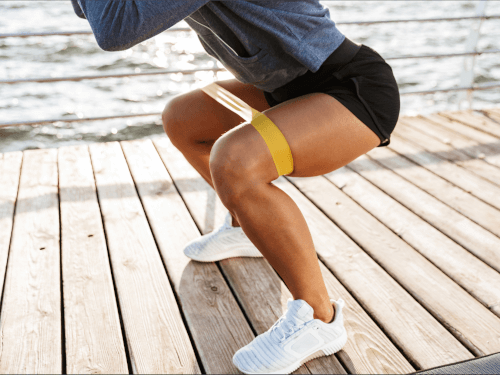Knee Pain Should NOT Be Your Normal When Doing Squats
Are you experiencing knee pain during or after squatting? There are many reasons this may occur. Today, we’re focusing on one of the most common issues we see – your knees going forward while squatting.
This often occurs due to a lack of engagement with the correct muscles that control the sitting and squatting mechanics of the body – the quadriceps, the large muscle above the knee covering the front of the thigh.
One way you can easily discover if this is something you’re doing is to squat while watching your form in the mirror. Are your knees jutting forward over your feet, causing your heels to come up? If so, then your quadriceps are not being properly engaged. As you can see with our associate in the video, her body is stacked above her feet. Her back leans slightly forward, thus putting the brunt of her weight on the balls of her feet. This forces her knees to work extra hard to stabilize the motion.
Working extra hard to stabilize the downward motion of the squat while her weight is over the balls of her feet puts an excessive amount of stress on the knee joints. This stress results in knee pain while squatting, and is due to the lack of use of the quadriceps.
Start Squatting With a Hip Hinge to Remove Knee Discomfort
 The simplest way to correct this mechanical error is to implement a method called a “hip hinge”. A hip hinge is a technique that focuses on reaching the butt back and down simultaneously to sit down in a chair. This engages the quad muscles and thus eliminates excess knee tension.
The simplest way to correct this mechanical error is to implement a method called a “hip hinge”. A hip hinge is a technique that focuses on reaching the butt back and down simultaneously to sit down in a chair. This engages the quad muscles and thus eliminates excess knee tension.
As we see in the video, specialized physical therapist Shelby shows you how to engage your quadriceps muscles as you smoothly lower yourself to the chair. This stabilizes your knee joints and enables your feet to remain fully planted on the floor as you sit back.
Try implementing the hip hinge technique at home. First, your hands come forward as if they are placed flat on the table. Next, as you begin the squat, reach forward with them as if you are sliding them across the table as you push your butt back and down into the chair.
Working on this movement with a chair behind you to stop the sitting motion is a key proprioceptive practice. It will enable your subconscious mind to improve its confidence in the ability to execute the motion properly. It will also reduce your risk of injury when you go to add weight to the exercise.
The hip hinge method significantly reduces the tension put on your knee joints while squatting. By doing this, we optimize the benefits of the exercise while simultaneously working to eliminate lingering knee pain.
For more information regarding chronic knee pain, check out this blog which dives deeper into the relationship between EDS and hyper-mobility concerning knee pain. The team at Parr PT in Austin is here to help, please reach out to us to discuss your conditions and schedule a consultation.

Great Post! Everyone’s body is different, and it’s essential to listen to your body. If you experience persistent or severe knee pain, it’s advisable to consult with a healthcare professional to rule out any underlying issues and receive tailored advice on managing and preventing knee pain during squatting exercises.
Thank you for this comment. We always promote clients to seek a consultation with a physician with any acute or chronic pain to rule out any possible structural or other internal issues that may limit these types of exercises. We appreciate your feedback